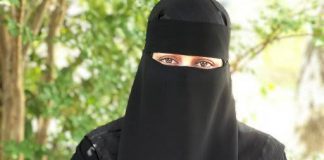Hijab is a veil that covers the head, chest and the whole body which is particularly worn by some Muslimwomen beyond the age of puberty in the presence of adult males outside of their immediate family and non-Muslim women.
It can further refer to any head, face, or body covering worn by Muslim women that conforms to a certain standard of modesty.
Hijab can also be used to refer to the seclusion of women from men in the public sphere, or it may embody a metaphysical dimension.
Most often, it is worn by Muslim women as a symbol of modesty and privacy. According to the Encyclopedia of Islam and Muslim World, modesty in the Quran concerns both men’s and women’s “gaze, gait, garments, and genitalia.
The Qur’an admonishes Muslim women to dress modestly. The Quran instructs both Muslim men and women to dress in a modest way, but it doesn’t insist on covering the head for the men
“Tell the believing men to lower their gaze and be modest – Quran 24:30.
The clearest verse on the requirement of the Hijab is Quran 24:30–31, asking women to draw their khimar over their bosoms.
“And say to the believing women that they should lower their gaze and guard their modesty; that they should not display their beauty and ornaments except what (must ordinarily) appear thereof; that they should draw their khimar over their breasts and not display their beauty except to their husband, their fathers, their husband’s fathers, their sons, their husbands’ sons, their brothers or their brothers’ sons, or their sisters’ sons, or their (Muslim) women, or the slaves whom their right hands possess, or male servants free of physical needs, or small children who have no sense of the shame of sex; and that they should not strike their feet in order to draw attention to their hidden ornaments” – Quran 24:31
“O Prophet! Tell your wives and your daughters and the women of the m believers to draw their cloaks (veils) all over their bodies (i.e. screen themselves completely except the eyes or one eye to see the way). That will be better, that they should be known (as free respectable women) so as not to be annoyed. And Allah is Ever Oft Forgiving, Most Merciful”
[Al-Ahzaab 33:59]
It was narrated from Safiyyah bint Shaybah that Aishah (may Allah be pleased with her) used to say: When these words were revealed – “and to draw their veils all over Juyoobihinna (i.e. their bodies, faces, necks and bosoms)” – they took their izaars (a kind of garment) and tore them from the edges and covered their faces with them.
(Narrated by Bukhari 4481)
Coming into other world religion like Christianity and Hinduism;
“For if the woman be not covered, let her also be shorn: but if it be a shame for a woman to be shorn or shaven, let her be covered.” – 1 Corithians 11:6
“How beautiful you are, my darling! Oh, how beautiful! Your eyes behind your veil are doves. Your hair is like a flock of goats descending from the hills of Gilead. – Song of Solomon 4:1
“Rebekah also looked up and saw Isaac. She got down from her camel and asked the servant,
“Who is that man in the field coming to meet us?” “He is my master,” the servant answered. So she took her veil and covered herself. – Genesis 25:64-65.
Moving to the Hindu scripture now to clearly see if truly Hijab is instructed in their scripture;
“When Brahma has made you a woman, you should lower your gaze and should not look up. You should put your feet together and you should not reveal what the garment and the veil conceals.”
[Rig Veda Book No. 8, Hymn No. 33, V.19]
So the Rig Veda says that the woman should wear the veil. They should lower their gaze and should not stare.
“Unlovely is the person is the husband who covers his thighs with the garment of his wife.”
[Rig Veda Book No. 10, Hymn No. 85 V.30]
“When Purshuram comes, Rama tells his wife Sita that “He is our elder, please lower your gaze, and put on the veil.
[Mahavir Charitra Act 2 Page 71]
If you read historical books, the books talking about the Coin Age, the Age of the Gupta and the post Gupta age, there are coins , on which there are pictures of the Indian woman wearing the veils and the veil are going up to their shoulders, some go up to the arms.
There are many Indian women in the villages who wear the veils; some of the women even cover their faces. So even the Hindu Scriptures say that a woman should wear the veil and lower their gaze.
But the most common nowadays is that Muslim women are the only ones who cover their hair.
It may be true that Islam is the only religion in which most women follow its directives to cover the hair, but it is not the only religion to have such directives.





